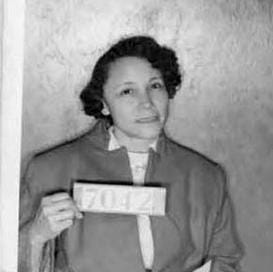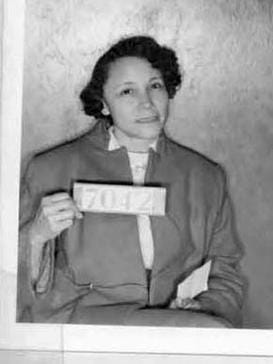Lightning makes no sound until it strikes. ~Martin Luther King, Jr.
Every January we rightly pause to remember and celebrate the life of Dr. Martin Luther King, Jr. – a man who tirelessly fought for racial justice and so eloquently stated the case for freedom that his words still send shivers down our spines.
He ascended to national attention during the Montgomery Bus Boycott of 1955-56.
A boycott that a Black woman theorized, organized, publicized, and began.
We know much about Dr. Martin Luther King, Jr.'s story.
I'd like to share hers.
Jo Ann Robinson grew up on a farm in Georgia – one of 12 children. She was the valedictorian of her high school class and went on to study at Columbia University in New York. After a brief career as a school teacher, she moved to Montgomery, Alabama in the summer of 1949 to become a professor of English at Alabama State College.
In December 1949, Robinson boarded the bus to the airport, laden with Christmas presents that she was bringing to the family she would visit during her two-week vacation in Ohio. She had closed her eyes, dreaming about her time off and the fun she would have.
She awoke from her reverie to a screaming bus driver, who was irate that she was sitting in the 5th row. At that time in Montgomery, the first ten rows were reserved for white passengers – whether those seats were taken or not – and sitting in a “whites only” section was prohibited.
In tears, she disembarked the bus.
She cried all the way to Cleveland.
She never forgot that incident, and although she had already joined the Women’s Political Council (which had been created in 1946 when the League of Women Voters refused to accept Black members), in 1950 she became its president.
She grew the WPC’s membership to hundreds of members in nearly every corner of, and every workplace in, Montgomery. As she explained it later – they “were organized to the point that [they] knew that in a matter of hours [they] could corral the whole city.”
Soon enough, they’d need to.
While WPC was committed to voting rights and civil rights, the treatment of Black riders on city buses remained a focus for Robinson, who bristled when she learned that what happened to her on that bus in December 1949 was not uncommon.
So, she and the WPC began to lobby the city and the bus company for better treatment.
She theorized that a boycott of the buses could have a significant impact – between 75-80% of the bus patrons were Black, after all.
So after Brown v. Board of Education deemed segregation unconstitutional in public schools in 1954, she increased the intensity of her lobbying efforts – and in a letter to the mayor hinted of a bus boycott if segregation continued.
What the mayor didn’t realize was that Robinson’s letter wasn’t an empty, off-hand threat; Robinson and the rest of the WPC had been hard at work for years planning and organizing for a bus boycott. While it was true that the boycott appeared to be spontaneous to those who weren’t members of the Women’s Political Council, the truth was that they had been preparing for it for at least three years.
They were simply waiting for the right opportunity to implement their plan.
That day came on Thursday, December 1, when Rosa Parks was arrested for not giving her bus seat to a white patron.
Robinson was informed right away, and got to work calling around to other WPC officers and supporters. She called as many of the men that had supported them as she could; she told them that Rosa Parks had been arrested. She told them Parks would be arraigned and tried, and would be in court on Monday. What should they do?
They were clear: “You have the plans, put them into operation.”
And that’s exactly what she did.
Robinson hurriedly drafted a flier on her home typewriter, fitting three messages to a page so they could produce multiple leaflets with each copy. As a professor at Alabama State College, she had access to a mimeograph machine (an early copier that used a stencil formed from an original that would be hand-cranked across a drum to produce a copy). A fellow professor let her into the school offices, where she and two of her students stayed up all night copying, cutting, and bundling the leaflets for distribution the next morning.
In total, they produced 35,000 fliers that night.
Then, with no sleep and after teaching her morning class, Robinson and her two trusted students distributed leaflets all across the city – to barber shops and bar halls, factories and schools.
The outreach worked. By Friday afternoon, thousands of the leaflets had changed hands many times – so that “[p]ractically every Black man, woman, and child in Montgomery knew the plan [to stay off the buses on Monday] and was passing the word along.”
Now the question was whether the community would follow the plan.
Sunday night was sleepless; Monday broke cold and dreary. Clouds threatened rain. Organizers worried that the weather would push people onto the buses.
So they held their breath as they watched the first buses roll by.
The first, empty.
The next, empty.
One, after another, after another, after another… empty, or nearly so.
The boycott was a massive, triumphant success.
That night, six thousand community members packed into the largest church in the city and committed to continuing the boycott indefinitely. As Robinson put it, “You see the Women’s Council planned it only for Monday, and it was left up to the men to take over after we had forced them really to decide whether or not it had been successful enough to continue, and how long it was to be continued.”
Also on that night, the Montgomery Improvement Association was created to continue to manage the boycott – with 26-year-old Dr. Martin Luther King Jr. as president.
Under King’s leadership, the Montgomery bus boycott continued for 13 months, and inspired a nation.
But most don’t know that the bus boycott began with a group of politically motivated Black women – led by Jo Ann Robinson – who had a great idea that they wouldn’t let go.
Most don’t know that for three years those women conceptualized, planned and organized a bus boycott – the success of which sent shockwaves throughout the country.
Most don’t know that an English professor distributed the 35,000 fliers she created advertising one of the most well-documented civil rights protests between her 8:00am and 2:00pm classes.
Most don’t know that after seeing the success of their protest, those same women handed off their accomplishments to “the men,” never demanding the spotlight or even credit for what they had done.
Women – particularly Black women – have been behind the scenes since, well… since forever.
Martin Luther King Jr. once said that lightning makes no sound until it strikes.
I love to hear the thunder.
So here’s to all of the women out there, planning and conceptualizing, theorizing and strategizing.
May you fly under the radar until you decide to thunder upon the stage.
Let’s get to work.
Jo Ann Robinson, Booking Photo
Actions for the Week of January 14, 2025
Here’s the part where – if you are so inclined – we roll up our sleeves and engage in what I like to call Action Therapy. In each Tuesday post I share a few “small things” – usually a Small Thing to Read, a Small Event to Attend, and a Small Call to Make or Action to Take. You can tuck these actions into your week with ease – and know that you’re doing something today to make tomorrow better.
Small Event to Attend: Tonight With Indivisible, Public Citizen, Working Families Party, and MoveOn.
Tonight at 8pm Eastern, Indivisible is co-hosting an event taking an in-depth look at the confirmation process and show you how to take action. During the call they will explain how you “can ensure your Democratic senators stand firm against the most egregious nominations.”
They promise to “lay out concrete actions people can take this week, and share thoughts on the path forward.” Sounds like a great event, no?
Small Call to Make or Action to Take: Oppose Pete Hegseth’s Nomination for DOD
This will be a busy week for confirmation hearings. (See the full week’s schedule here: https://www.cbsnews.com/news/trump-cabinet-confirmation-hearings-schedule/)
This week we will have confirmation hearings for AG nominee Pam Bondi, Homeland Security nominee (and famous dog killer) Krisi Noem, OMB nominee (and Project 2025 architect) Russel Vought, and DOD nominee Pete Hegseth.
No doubt there will be a lot of material to use in opposing these folks – but because his hearing is today and he is wholly unqualified to lead the Department of Defense – let’s focus our attention on Pete Hegseth.
The script is simple, and short. This will take you less than five minutes.
Don’t yet have your Senators’ telephone numbers programmed into your phone? No worries – you can find their contact info here: https://www.senate.gov/senators/senators-contact.htm
Script: Hi, my name is [name] and I’m a constituent at [zip code]. I want the Senator to oppose Pete Hegseth for Secretary of Defense. Besides the many issues with his character, his hearing today confirmed that he is wholly unqualified to lead the Department of Defense. Thank you.
Small Thing(s) to Read: Jack Smith’s Report and ProPublica’s Deep Dive on School Vouchers
No doubt you’ve already heard that last night the DOJ released Special Council Jack Smith’s report on the investigation into Trump’s efforts to overturn the 2020 election. At 174 pages, it’s a long read and I’m still working my way through it. I’m sure I’ll have more thoughts soon. In the meantime, I wanted to ensure you had a good link to a copy.
Read it at the DOJ website here: https://www.justice.gov/storage/Report-of-Special-Counsel-Smith-Volume-1-January-2025.pdf
Also, yesterday ProPublica published an incredible piece digging deep into the history of vouchers – specifically in Ohio. It’s not just a fascinating read; I think it’s really important context to understand the origin and intent of the “school choice” movement. Check it out here: https://www.propublica.org/article/school-vouchers-ohio-church-state-tax-dollars-private-religious
Thanks for reading, friend – I’m glad to see you here! If you like what I do and you want to support it, consider becoming a paid subscriber. I couldn’t do this without you.





Yes! Thank you. I'm making 3 calls today - about Hegseth, about immigration, and about LGBTQ legislation. Grateful for your work.
Another part of the story was that a woman organizer planned to sit in the white section and allow herself to be arrested. Dr. king got involved with the plan. However, he asked her to step down as he had an experienced civil rights worker to step in and do the plan. That is the history most know about.